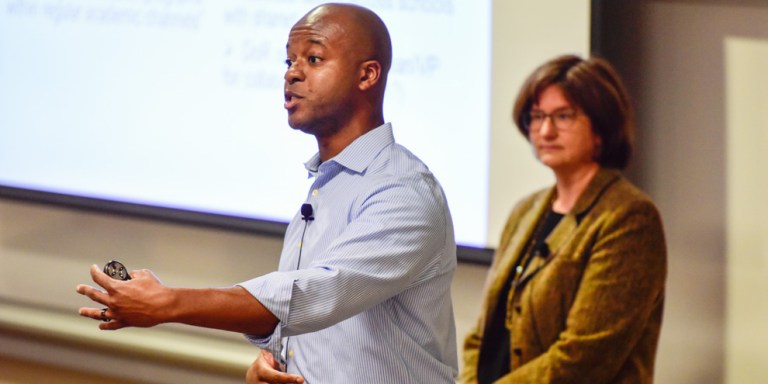In its meeting on Thursday, the Faculty Senate heard reports on Stanford’s long-range planning from representatives of the four area steering groups (ASGs) tasked with consolidating the proposals submitted to the University. The ASGs focused on education, research, community and engagement beyond the University. The reports highlighted significant components of the 37 white papers generated from proposals submitted by 2,000 Stanford community members last year.
The education group focused its presentation on fostering innovation in the classroom. Associate Dean for Student Affairs and Associate Professor of Education Bryan Brown spoke about harnessing the ingenuity that drives Stanford’s research for the classroom.
“Many of the proposals challenge Stanford to say that one of our objectives [is] that we are a world leader in understanding the best ways for learning to happen,” Brown said. “In order to do that, we have to take some bold steps and think differently about our educational program.”
The education group also touched on student and faculty diversity, nurturing learners and gearing education towards real world problems. A suggestion to ban lecturing drew chuckles.
Interdisciplinary work featured prominently in the research steering group’s discussion. One proposal suggested “pop-up” institutions that exist for several years and draw together professors from disparate fields. Temporary institutes incentivize the creation of new collaborations by reducing costly long-term commitments, according to John Dabiri, professor of mechanical engineering and civil and environmental engineering. Currently, the Stanford Catalyst for Collaborative Studies funds interdisciplinary groups for three years with grants of up to three million dollars.
“The connection of faculty across schools is something I personally think is a big missed opportunity at Stanford,” Dabiri said. “We have a lot of expertise across campus, but it’s rare that we have convening groups where those faculty interact. We miss out on a lot of opportunities for research interaction.”
The community steering group specifically addressed issues related to diversity on campus. The Stanford student body is 36 percent white and has a near-even split between men and women, according to the Diversity and Access office. Additionally, the office reports that the faculty is 72 percent men, and 71 percent of faculty are listed as “non-minority.”
“There is a very large mismatch between the composition of our student body and our faculty,” biology professor and Community steering group co-chair Susan McConnell said. “We’ve been trying hard for ten years. We’ve made no progress in terms of ethnicity and race and modest progress in terms of gender.”
The steering group also considered making community service a larger part of Stanford’s mission.
“A series of proposals suggested that service either to the local community or a broader community should become a fundamental, near-requirement for all members of our Stanford community,” said Stanford Cardiovascular Institute Director Joseph Wu.
Provost Persis Drell described the next stages for the white papers. She said that the 30-day window for public comment will end next week. Drell and President Marc Tessier-Lavigne will also attend several meetings about the proposals, gearing up for a “high level vision” presentation to the board in April. A larger presentation to the community will occur sometime in late spring.
Contact Nicholas Midler at midler ‘at’ stanford.edu. Contact Christina Pan at capan ‘at’ stanford.edu.
